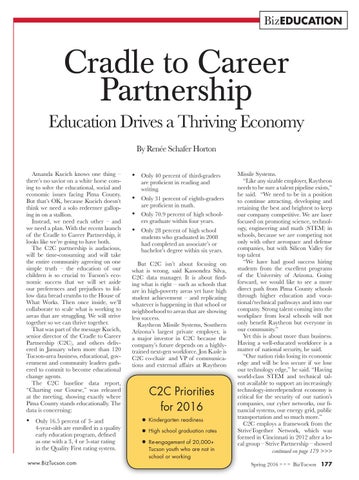BizEDUCATION
Cradle to Career Partnership
Education Drives a Thriving Economy By Renée Schafer Horton Amanda Kucich knows one thing – there’s no savior on a white horse coming to solve the educational, social and economic issues facing Pima County. But that’s OK, because Kucich doesn’t think we need a solo redeemer galloping in on a stallion. Instead, we need each other – and we need a plan. With the recent launch of the Cradle to Career Partnership, it looks like we’re going to have both. The C2C partnership is audacious, will be time-consuming and will take the entire community agreeing on one simple truth – the education of our children is so crucial to Tucson’s economic success that we will set aside our preferences and prejudices to follow data bread crumbs to the House of What Works. Then once inside, we’ll collaborate to scale what is working to areas that are struggling. We will strive together so we can thrive together. That was part of the message Kucich, senior director of the Cradle to Career Partnership (C2C), and others delivered in January when more than 120 Tucson-area business, educational, government and community leaders gathered to commit to become educational change agents. The C2C baseline data report, “Charting our Course,” was released at the meeting, showing exactly where Pima County stands educationally. The data is concerning:
•
Only 16.5 percent of 3- and 4-year-olds are enrolled in a quality early education program, defined as one with a 3, 4 or 5-star rating in the Quality First rating system.
www.BizTucson.com
•
Only 40 percent of third-graders are proficient in reading and writing. • Only 31 percent of eighth-graders are proficient in math. • Only 70.9 percent of high schoolers graduate within four years. • Only 28 percent of high school students who graduated in 2008 had completed an associate’s or bachelor’s degree within six years. But C2C isn’t about focusing on what is wrong, said Kassondra Silva, C2C data manager. It is about finding what is right – such as schools that are in high-poverty areas yet have high student achievement – and replicating whatever is happening in that school or neighborhood to areas that are showing less success. Raytheon Missile Systems, Southern Arizona’s largest private employer, is a major investor in C2C because the company’s future depends on a highlytrained next-gen workforce. Jon Kasle is C2C co-chair and VP of communications and external affairs at Raytheon
C2C Priorities for 2016
• Kindergarten readiness • High school graduation rates • Re-engagement of 20,000+
Tucson youth who are not in school or working
Missile Systems. “Like any sizable employer, Raytheon needs to be sure a talent pipeline exists,” he said. “We need to be in a position to continue attracting, developing and retaining the best and brightest to keep our company competitive. We are laser focused on promoting science, technology, engineering and math (STEM) in schools, because we are competing not only with other aerospace and defense companies, but with Silicon Valley for top talent “We have had good success hiring students from the excellent programs of the University of Arizona. Going forward, we would like to see a more direct path from Pima County schools through higher education and vocational/technical pathways and into our company. Strong talent coming into the workplace from local schools will not only benefit Raytheon but everyone in our community.” Yet this is about more than business. Having a well-educated workforce is a matter of national security, he said. “Our nation risks losing its economic edge and will be less secure if we lose our technology edge,” he said. “Having world-class STEM and technical talent available to support an increasingly technology-interdependent economy is critical for the security of our nation’s companies, our cyber networks, our financial systems, our energy grid, public transportation and so much more.” C2C employs a framework from the StriveTogether Network, which was formed in Cincinnati in 2012 after a local group – Strive Partnership – showed continued on page 179 >>> Spring 2016 > > > BizTucson 177
